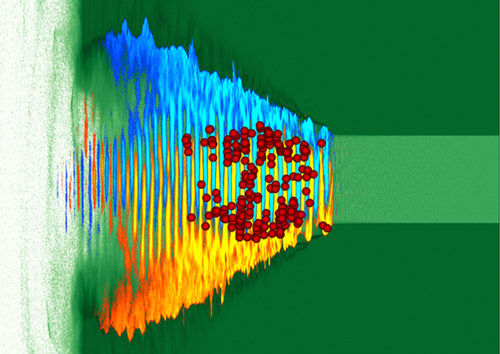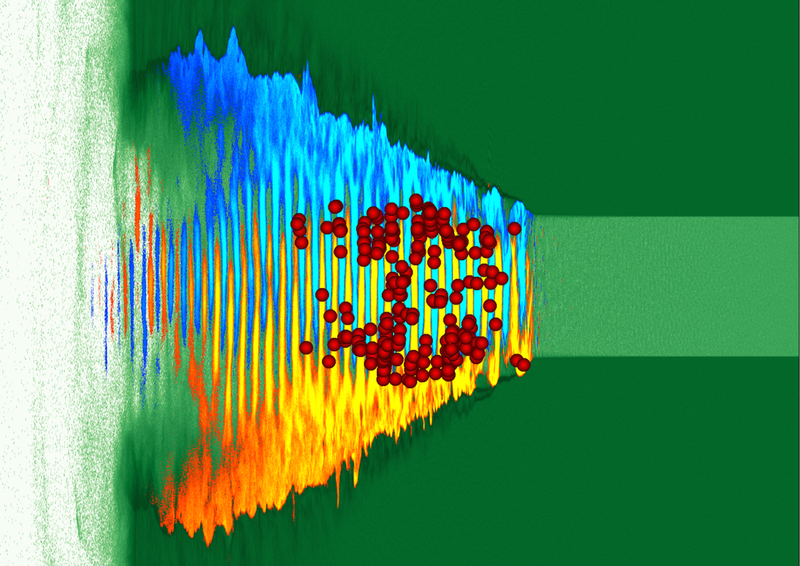How to Make an Intense Gamma-Ray Beam
Intense beams of gamma rays would find a host of uses in fundamental physics research, nuclear fusion, and medicine, but they are hard to produce. A team has now used computer simulations to show that a powerful laser hitting a plastic surface can generate intense gamma-ray emission. In the simulations, the laser light creates a plasma in the plastic and accelerates electrons enough to produce large numbers of gamma-ray photons. The researchers say that the system might work with current technology.
In extreme astrophysical environments, such as near a supermassive black hole, matter and antimatter (electrons and positrons) regularly annihilate, producing gamma rays. Researchers would like to study the reverse process by colliding beams of gamma rays, which should create electrons and positrons, a transformation of light into matter [1]. Gamma-ray beams could also enable a wide range of other fundamental experiments and might have a role in radiation therapy and radiosurgery [2]. Previous attempts to make these beams involved the interaction of a laser beam with an electron beam [3]. But to produce copious gamma-ray photons with energies in the MeV range, the laser beam would need to be more intense than any current device.
Alexey Arefiev at the University of Texas at Austin and his co-workers now propose a different method that requires somewhat less laser power. It involves shining pulses of a petawatt infrared laser onto a carbon-rich, plastic target. The power density of such a pulsed laser can reach around , which is about 500 times greater than would be produced by focusing all of the sunlight reaching the Earth onto a pencil tip.
In the team’s scenario, the laser pulse heats the target, creating a plasma of electrons and ions. The electrons in the plasma are high-energy, and according to special relativity, they acquire a large effective mass, making them too sluggish to follow the oscillations of the laser’s electromagnetic field. This effect renders the plasma transparent to the light, so the laser beam can penetrate tens of micrometers into the target, filling it with a dense plasma.
In the team’s simulations, the laser pulse pushes the electrons in this plasma forward, like a leaf blower propelling leaves, and this motion of charge sets up a strong magnetic field that curls around the axis of the laser beam. This field accelerates the electrons forward even more but along zigzag trajectories as they move through the plastic. This electron motion generates so-called synchrotron radiation of very high energy (gamma-ray photons) that is emitted from the rear of the plastic target in the direction of the laser beam.
The simulations that Arefiev and colleagues conducted using the Stampede supercomputer at the University of Texas showed that the method works in principle—but also that propagation of the laser pulse into the target may quickly become unstable and deviate from its original direction. Then the electrons are pushed in random directions, and the multi-MeV photons they emit exit in an uncoordinated spray. “It’s similar to what happens to a garden hose that, when left unattended, can spray water uncontrollably everywhere,” says Arefiev.
To provide a stabilizing “hand on the hose,” the researchers propose adapting the structure of the target. They simulated the same process for a target containing a cylindrical channel of lower density—a plastic foam, say, surrounded by the denser material. When the laser pulse hits this channel, the resulting plasma becomes completely transparent, whereas the surrounding material is opaque. So the channel funnels the laser pulse and ensures that it stays on course, producing a narrow, intense beam of forward-moving gamma rays.
“We hope that our results will motivate experimentalists to test our predictions,” says Arefiev. The conditions they have simulated “might be within reach for existing laser facilities.”
Donald Umstadter of the University of Nebraska at Lincoln, who works on new laser technologies, says that the gamma-ray beam could be used to study nuclear weapons materials that are relevant for managing the large stockpile of obsolete warheads. However, he also foresees many potential engineering difficulties in putting the idea into practice.
The expected magnetic field would be 10 times stronger than that of any previous laser plasma, says Tony Bell of the University of Oxford, UK. But “the simulations are credible,” he says. “If it is successful, the beam of gamma rays thus generated would be extraordinarily intense.”
This research is published in Physical Review Letters.
–Philip Ball
Philip Ball is a freelance science writer in London. His latest book is How Life Works (Picador, 2024).
References
- X. Ribeyre, E. d'Humières, O. Jansen, S. Jequier, V. T. Tikhonchuk, and M. Lobet, “Pair Creation in Collision of -Ray Beams Produced with High-Intensity Lasers,” Phys. Rev. E 93, 013201 (2016).
- K. J. Weeks, V. N. Litvinenko, and J. M. J. Madey, “The Compton Backscattering Process and Radiotherapy,” Med. Phys. 24, 417 (1997); B. Girolami, B. Larsson, M. Preger, C. Schaerf, and J. Stepanek, “Photon Beams for Radiosurgery Produced by Laser Compton Backscattering from Relativistic Electrons,” Phys. Med. Biol. 41, 1581 (1996).
- S. Chen et al., “MeV-Energy X Rays from Inverse Compton Scattering with Laser-Wakefield Accelerated Electrons,” Phys. Rev. Lett. 110, 155003 (2013).





